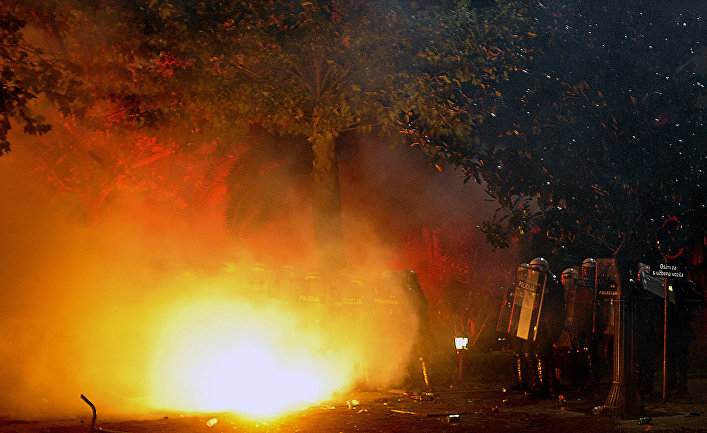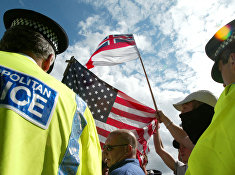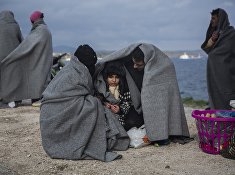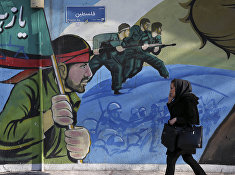The Defense Ministers of western nations have invited Montenegro to join NATO as the 29 member of the security alliance. Moscow sense that invitation as a sleight which confirms all their suspicions of the West's expansionist agenda – including in the Balkans. For Washington this step contains no hostile feeling – since, as US Secretary of State John Kerry has said “NATO is a defensive alliance – which has existed for 70 years, and is not directed against Russia.”
It would be interesting to know why NATO has chosen this particular moment to provoke aggression with Moscow? Surely NATO's top commanders don't assess the NATO accession of a tiny Balkan nation as a greater priority than good relations with Moscow – whose allegiance is vital for any victor in the struggle with the Islamic State, whom President Obama has himself named as the “common enemy?” Especially when we consider that Montenegro has been on the NATO waiting-list for ten years, with public opinion there far from united on joining NATO, and continuous propaganda campaigns for joining the Alliance held there (paid for with NATO cash) and featuring sportsmen, actors and singers.
Invitation to Montenegro to join NATO affects Russia's interests and proves the Alliance's expansion its mode of existence.
— Russian Embassy, UK (@RussianEmbassy) December 7, 2015
The NATO announcement comes at a time when there is already heightened tension between Russia and the West. Several days ago Turkey – a member of the NATO alliance – shot down a Russian warplane, which might have triggered a cycle of retaliation, and it was only due to cool heads in the Kremlin that an international crisis was avoided. The results of a visit by French President Hollande to Moscow were a recognition of the role Russia is playing in Syria against ISIL, along with increased willingness from the West to coordinate its operations with those of the Kremlin. But now NATO's decision threatens a fresh divide. There's a clear impression that there's somebody within the Western alliance pulling all the stops to wreck relations with Moscow.
Poland wants NATO nukes to counter Russia threat https://t.co/5cxSfgQIJR pic.twitter.com/jajAuSiMq9
— RT (@RT_com) December 6, 2015
In an interview given several days ago, which was simultaneously published throughout major Western media, NATO Secretary Jens Stoltenberg – the mastermind of the entire Montenegro deal – made vicious allegations about Russia. Stoltenberg claimed Russia is a threat to security throughout the whole of Europe — on the grounds of its aggressive policies directed at Ukraine, and because of Russia's military build-up “which hits an extreme which we have not seen since the end of the Cold War.”
Is Russia threatening us – or are we threatening Russia?
But how sure are we of this stereotype of a threatening Russia – and of NATO trying to save its members from the rampaging 'bear from the East' – is actually the real situation? Or couldn't it be a justification for Western expansionist policies with Washington in the driver's seat? If we take a realistic view of the situation in Europe, it seems clearer and clearer that there's an encroaching cordon gathering around Russia – to which Russia replies with attempts to safeguard its own territories. The Ukraine crisis can also be viewed in this light.
We see the military might of the opposing parties. Russia's military infrastructure today is only one-fifth of what the former USSR could have mustered — whilst NATO has enormously augmented its offensive (or meaning defensive) arsenals over the last twenty years, gobbling up the countries of the former Warsaw Pact and neighboring neutral countries in the process. If we look at military expenditure, then the USA spends eight times more on its military budget than Russia. According to the International Institute for Strategic Research, in 2014 the NATO nations ploughed 800 billion dollars into defense spending – compared with only 70 billion spent by Russia.
Military budget: @NATO = $850.000.000.000 (2015) [#USA = $650.000.000.000 (2015)] #Russia = $85.000.000.000 (2014) => 10% of @NATO
— Mister X (@StopHatinRussia) August 21, 2015
To fully comprehend the deranged Western thinking, we need only read an article which appeared a few months ago in La Stampa – in which the authors suggest that Russia is not only getting ready to attack all of Europe… but that it's going to do so with less than half of NATO's massive war-chest. Hello? So, we presume, Russia is set on a path of suicide.
Where Russia does come up to par with NATO forces is in the sphere of nuclear weapons, in which it possesses (just as the USA does) a so-called 'triad' – meaning a nuclear arsenal capable of being deployed simultaneously in three different theaters of war, on land, by air, and at sea.
Sustainable pressure
The last year has seen the highest tensions between Washington and Moscow since the Cold War. The Ukraine crisis gave the US and its allies a pretext for mass deployment of military forces in Eastern Europe (Poland and Romania), and in the Baltic States. NATO's last Annual Report states that during 2014 the Alliance warded-off 400 Russian aircraft – (four times more than in 2013) on its eastern borders.
In response, Russia has stated that it intercepted more than 200 NATO warplanes in just one region – over the Baltic and Barents Seas, at the Arctic and Norwegian borders. Of these, 140 aircraft were American, while the others were German, Canadian, Portuguese, Danish… and even Swedish, a country which is not even in NATO at all, but is undertaking NATO missions. On top of this we can add Russia's interception of over 460 British and French AWACS-system aircraft in the Ukraine and Black Sea region, as well around 20 in 2013 over the Russia/Belarus border.
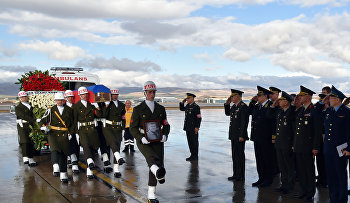
Both sides have been carrying out large-scale military exercises. In March Russia set up an impressive military exercise operation which involved the participation of 80,000 troops, 65 warships, 220 warplanes, and 316 submarines along the Arctic borders (the Kolsky Peninsular), the borders of Poland and Lithuania (Kaliningrad, a Russian territory), in the Crimea, and in the Black Sea. Likewise in October NATO responded with war games titled Trident Juncture 2015. This operation included 36,000 troops from over 37 countries (in other words, all 28 NATO countries, plus 9 NATO partner countries). The aim of such NATO exercises is to test quick-response capabilities in the event of an attack on a NATO-member country from the East. The number of countries from whom such a putative attack might be launched is, of course – just one.
Who is fanning the flames?
One of Europe's most influential strategic analysts, Ian Kearns recently wrote that “neither side will declare so openly – but the Russian armed forces are preparing for a clash with NATO, and NATO is preparing for a clash with Russia.”
None of what is happening is in Europe's interests – nor are they in Russia's interests either. On the contrary, both Europe and Russia have interests in building joint security understandings and integration. Many of the issues which face Europe and Russia – terrorism, the economic crisis, energy issues, the Middle East scenario, and so on, are identical.
So who is fanning the flames? Who has interests in driving a wedge between Moscow and Europe? Who is pouring oil on the gathering flames? Very probably we need to look towards Washington for answers to these questions.
